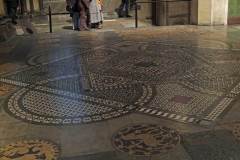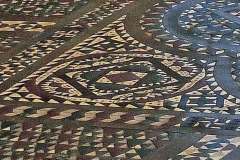In 1220 the remains of Thomas Becket were removed from his tomb in the eastern crypt and ‘translated’ to his new shrine in the trinity chapel. The new shrine was set in a paved area which included the 36 roundels and a mosaic known as the Opus Alexandrium, named after the Roman emperor Alexander Severus. The complicated pattern of the polychrome Opus Alexandrium, made of coloured Italian marble, represents ‘a lozenge in a quatrefoil in a square in a much bigger lozenge overlapping four circles’. Writers disagree on whether it was laid initially for the new shrine or lifted from an earlier configuration in the cathedral and re-laid for the new shrine. Whatever its origins, the mosaic has been described as ‘perhaps the most splendid ever laid in medieval England’. Note: the Opus is currently (March 2013) covered by a mat bearing an image of the floor itself – the reproduction is excellently done and to the casual observer it looks like the real thing.
What to see:
- the setting of the Opus Alexandrinum in the Trinity chapel between two blocks of roundels (Image 1)
- the detailed design of the Opus, a fine example of what is known as tassellate work (Image 2)
Sources; see standard cathedral sources; also Canterbury Cathedral Chronicle 1999 (article by Margaret Sparks)
DL


